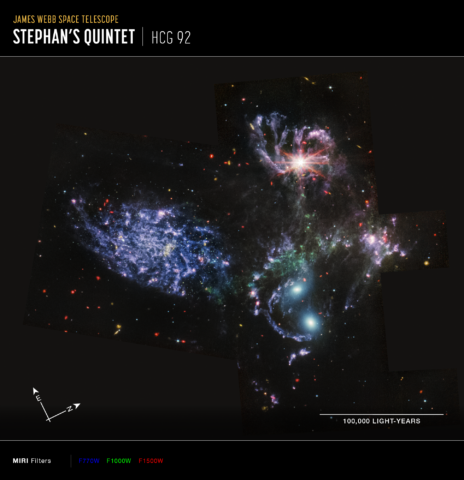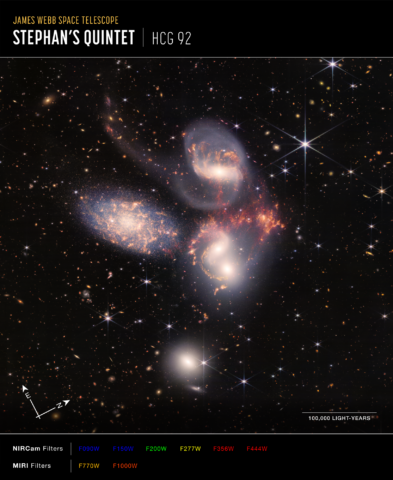The first observations made by the James Webb Space Telescope were posted live on NASA TV on July 12 at 11:30 pm Korean time (July 12, 10:30 am EST). There are five high-resolution images and spectral spectra publicly available: the galaxy cluster SCAMS 0723, the hot gas exoplanet WASP-96b (spectral spectrum), the nebula NGC 3132 known as the Southern Ring Nebula, the Quintet of Stephan and the Carina Nebula. The edge of NGC 3324 includes the “cosmic cliff”. (See related article – “James Webb Space Telescope Reveals First Observation Results”)
In the James Webb Space Telescope Observation Interpretation series, we examine the high-resolution images one by one to find out what the images mean and what James Webb’s plans are for the future of celestial bodies. James Webb’s fifth image is a group of five galaxies called Stephan’s Quintet, which became a hot topic because it was possible to catch hints of the evolutionary process of galaxies that hadn’t been seen before.
Stefano’s Quintet
In 1877, the French astronomer Édouard Stephan discovered a group of galaxies in the constellation of Pegasus (NGC 7317, NGC 7318a, NGC 7318b, NGC 7319 and NGC 7320c) at the Marseille Observatory. Subsequently, the Group of galaxies (a group of fewer than 50 galaxies linked to each other by gravity) was nicknamed “Stephan’s Quintet” and the Hickson Compact Group 92 (HCG 92), also known as The Group of galaxies of above has a very severe redshift of 790-6747 km / s, with an apparent magnitude of +13.9 to +16.7.
From left to right, we find the galaxy NGC 7320c, the galaxy NGC 7319, the galaxy NGC 7318b (UGC 12100), the galaxy NGC 7318a (UGC 12099) and the galaxy NGC 7317. © NASA, ESA and the Hubble SM4 ERO team
–
The image above, taken with the Hubble Space Telescope alone, is so beautiful and wonderful that you can see the universe. From left to right, you will find NGC 7320c, NGC 7319, NGC 7318b (UGC 12100), NGC 7318a (UGC 12099) and NGC 7317. NGC 7317 and NGC 7318a are ellipsoidal in shape. galaxies are shaped like barred spiral galaxies.
The interesting thing about the group above is that, although nicknamed the quintet, there are actually only 4 galaxies in the group (NGC 7317, NGC 7318a, NGC 7318b, and NGC 7319). These four galaxies are approximately 290 million light years apart. The rest of the NGC 7320c galaxies seem to coincidentally be together because they have the same line of sight from Earth and are approximately 40 million light years from Earth.
The apparent size of the cluster above is about one fifth of the moon’s diameter. Furthermore, this group of galaxies is relatively close compared to other galaxies, usually billions of light-years away. Due to this proximity, they are a group of galaxies that can be studied in more detail by merging and interacting with galaxies, which are very important for galactic evolution. These interactions allow for detailed observations of how galaxies mutually trigger star formation and how gases are perturbed. Therefore, astronomers call this group of galaxies a “fantastic laboratory” for studying galaxies. What new information could be revealed by observing the cluster of galaxies above with the unprecedented resolution of the James Webb Space Telescope?
–
–
Stefan’s quintet observed with mid-infrared light
The image below is an image of Stephen’s quintet taken with the MIRI (Middle Infrared Instrument) of the James Webb Space Telescope. Note that the galaxy NGC 7317 is not included in the image above. The compass north and east arrows show the direction of the image when viewed from below and the direction when viewed from above must be reversed. The scale bar is expressed in light years, the distance light travels in a year, and it takes about 100,000 years for light to travel the length of the scale bar. For reference, a light year is equal to 9.46 trillion km (or approximately 5.88 trillion miles). This shows that the object shown in the image above is approximately 370,000 light years in diameter (as the galaxy NGC 7317 is not included).

Stefan’s quintet viewed in mid-infrared light, clockwise from the left, NGC 7320c, NGC 7319, NGC 7318b and NGC 7318a are visible. © JWST / NASA, ESA, CSA, STScI
–
The image above shows the wavelength of the invisible mid-infrared converted to the color of visible light. The letters listed in different colors below the image indicate the MIRI filter used to collect the light. The color of each filter name is the visible light color used to represent the mid-infrared passing through that filter and is a composite of single exposures. (Go to the high resolution photo)
Stefan’s quintet observed with near infrared and mid infrared
The image below is an image of Stephen’s quintet taken with NIRCam (Near-InfraRed Camera) and MIRI (Mid-InfraRed Instrument) from the James Webb Space Telescope. For reference, the above image includes the galaxy NGC 7317, providing a complete picture of Stefan’s quintet. Again, the north and east compass arrows show the direction of the image when viewed from below, and the scale bar shows that the size of the celestial body displayed in the image above is approximately 62,000 light years.

From left to right, the galaxy NGC 7320c, the galaxy NGC 7319, the galaxy NGC 7318b, the galaxy NGC 7318a and the galaxy NGC 7317 are visible. © JWST / NASA, ESA, CSA, STScI
–
The image above shows the near infrared and mid infrared wavelengths converted to the colors of visible light. The letters listed in different colors below the image represent the NIRCam and MIRI filters used to collect the light. The color of each filter name is the color of visible light used to indicate the near and mid infrared that passes through that filter and is a composite of single exposures. The image above is an image that contains over 150 million pixels and is a composite of over 1,000 individual image files.
The above photograph of the Milky Way as seen through James Webb’s eyes is neither surprising nor terrifying. Countless galaxies and stars have been photographed in the background of the group and numerous objects have been revealed around the group that have never been seen with any space telescope. Thousands of celestial backgrounds reminiscent of Hubble’s Deep Fields are enough to thrill the audience. Bright clusters of millions of young stars and newly formed regions have also been photographed, and the galactic group is one of the sharpest astrophotography ever made.
In the photo above, two of the three MIRI filters were used and, through this, the hot gas and dust structures in the galaxy, the shock waves between galaxies and their interactions are well exposed. Specifically, the MIRI image of the cluster of galaxies captures a huge shock wave as galaxy NGC 7318B passes through the cluster, which surrounds the central pair of galaxies and appears red and gold.
Furthermore, in the group of galaxies observed using NIRCam, the galaxy’s bright core and several stars were captured in the galaxy NGC 7320, which is the galaxy furthest to the left and closest to us. In particular, aging and dying stars have a red dot-like appearance. (Go to the high resolution photo)
→ Continued on next page on paper. (View the related article – “How Galaxy Evolution Proceeds, Part 2”)
Guide to the series “Interpreting the first observations of the James Webb Space Telescope”.
Deep Field Information: James Webb’s Deep Field Was So Beautiful – Part 1
Deep Field Information: James Webb’s Deep Field Was So Beautiful – Part 2
Exoplanet Related: Discovery of water in the atmosphere of a hot gas planet
The death of a star: a closer look around a dying star – Part 1
The Death of a Star: A Closer Look Around a Dying Star – Part 2
Star Birth Related: Carina Nebula’s “Cosmic Cliffs” revealed in detail
Galaxy Related: How Galaxies Evolve – Part 1
Galaxy Related: How Galaxies Evolve – Part 2
(763)
–


